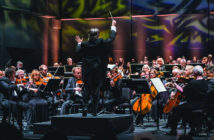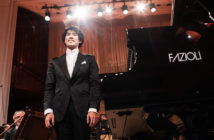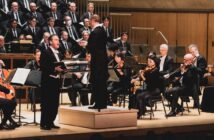The lobby of the Cologne Philharmonie. CDs arrayed on a table. Subscribers to the Internationale Orchester series looking them over with quiet curiosity.
“This is excellent,” said I, tapping on the Orchestre Métropolitain’s ATMA recording of Debussy’s La Mer, arguably the biggest hit on the playlist of a six-city whirlwind tour of Europe.
“Of course!” a middle-aged woman responded, almost with indignation. “Yannick!”
Of course: Yannick. Germans are on a first-name basis with the conductor whose surname is Nézet-Séguin, as are the Dutch, who heard him lead the OM Wednesday in the matchlessly resonant Royal Concertgebouw in Amsterdam.
Whether the Concertgebouw represented the peak of the tour remains to be heard – Rotterdam, Hamburg and two concerts in Paris beckon – but the conductor seemed to feel a new plateau had been reached.
“An evening like tonight shows what it means for a conductor to have a relationship with an orchestra for so long,” Nézet-Seguin, music director since 2000, said at a post-concert press scrum.
“And it is a matter also of stability. Many of the musicians are founders of the orchestra 37 years ago. Being together, you make better music.”
Naturally the acoustics of this famous 1888 edifice help – “amplified by history,” as Stéphane Tétreault, the soloist in Elgar’s Cello Concerto, commented succinctly. But great music does not make itself. Coarse playing will be heard as such. Noncommittal soft playing never leaves the stage.
“It is something physical that becomes metaphysical,” Nézet-Séguin said about the high-definition pianissimi he elicited (and was granted) in Debussy, Elgar and Ravel’s Concerto for the Left Hand. “Now I think we have reached this level with the Métropolitain.”
Nézet-Séguin’s faith in the musicians could be measured by his decision to dispense with a baton in La Mer. Part of his rationale was to force the close listening that the Concertgebouw demands.
Was the Amsterdam performance a touch more ecstatic in its evocation of sunrise and sea spray? “I had way more fun at the Concertgebouw,” one veteran string principal said. “More animated,” added an extra in the brass.
To these ears, both were exquisite. Debussy asks unreasonably for 16 cellos divided four ways in the first movement. In Cologne and Amsterdam we heard how eight disciplined players in a nautical frame of mind can do just fine.
Four fine horns were also much appreciated at the quiet start of the coda, which the conductor brought organically to a stirring climax. No less magical was the end of the second movement, a tapestry of wind and percussion threads woven with delicate harps. The pulse of the finale was irresistible. Everyone thinks of colour in this music, but rhythm is what brings the seascape to life.
An ovation in both cities ensued. As did an appreciative speech in English from the stage. Then, as an encore, Elgar’s Nimrod, wonderfully soft-spoken except where it must release its pent-up emotions in late Victorian splendour.
Every concert on this tour except the last two begins with music from Quebec, either Pierre Mercure’s Kaléidoscope of 1948 (this was the opening salvo on Sunday in Dortmund) or Exil intérieur (2012) by the former OM composer-in-residence Éric Champagne. I was seated too close to the stage of the Cologne Philharmonie (a wraparound amphitheatre of 1988) to have fond thoughts about this 16-minute potpourri of consonant and dissonant impulses, which reaches at least 10 resounding fortissimo conclusions before well and truly coming to an end. The earsplitting fanfares and gratuitous woodwind solos were easier to take in Amsterdam. But it must be reported that both crowds gave the anti-minimalist manifesto a hearty welcome.
After Champagne came caviar, in the form of Ravel’s Concerto for the Left Hand. There could be no misty beginning in the acoustically vivid Cologne Philharmonie, although the contrabassoon line was, lyrically speaking, right on. Alexandre Tharaud sounded more sustained in the Concertgebouw (where the piano itself seemed to be in better condition). But this Frenchman with a fondness for Quebec struggled in the opening minutes to create the majestic effect that this astonishing masterpiece demands as a birthright. On both nights he used the score.
No such crutch for Tétreault, who combined expressive phrasing and plangent tone to create a personal interpretation of a work that requires nothing less. The 24-year-old was styled a “daredevil” by Concertgebouw general manager Simon Reinink after the performance for his wide dynamic range. Rhythms also were remarkably free, and touches of portamento, where appropriate, were provided.
None of this sounded appliquée. Indeed, Tétreault’s instinct for applying and withholding vibrato was so natural that it took an act of critical effort to notice it. “You play even better, rather than being intimidated,” Nézet-Séguin told the cellist, referring to the all the ghosts occupying the Concertgebouw. “And this is the sign of the greats.” The OM accompaniment was suitably warmhearted.
Happily, the Paris Philharmonie performance of the Cello Concerto on Saturday will be broadcast on Mezzo Live HD. (Go to www.mezzolivehd.tv for information.) Come to think of it, an old-fashioned stereo recording might be nice. Of course, Tétreault records for Analekta, Nézet-Séguin for ATMA. Perhaps we could create a hybrid label: A & A.
Not that this was a concert of concertos, even if the initial tour concept as formulated in Paris was notably heavy on soloists. The takeaway in Dortmund, Cologne and Amsterdam was of a very good orchestra playing in harmony with its conductor.
“The atmosphere is relaxed but at a high level,” principal horn Louis-Philippe Marsolais said over breakfast in Amsterdam. “He (Nézet-Séguin) expects the best, but he knows he will not get this by picking on you.”
“When he’s there, he calms everyone down,” concurred principal trombone Patrice Richer, a veteran of 1999 who joined when Joseph Rescigno was music director. “He just has faith in everyone, no matter who it is. He makes people feel better and play better.”
As for the Concertgebouw gig, it could be called a dream come true, except that few OM musicians ever supposed that their journeys would extend farther than Toronto, let alone overseas.
“We have heard so much about this hall,” Richer said. “It is part of everyone’s upbringing. You go to school and think, ‘I’d love to play there.’
“And now we are here. Never in a million years did I think this would happen.”
Passing notes: The OM musicians arrived in Rotterdam on Thursday by noon to attend a reception given in City Hall by the by the mayor, Ahmed Aboutaleb, who said kind words about Nézet-Séguin while reminding everyone of the role Canada played in the wartime liberation of the Netherlands.
Also on hand were members of the Rotterdam Philharmonic, of which YNS is the outgoing chief conductor. Soloists in Rotterdam are contralto Marie-Nicole Lemieux in Berlioz’s Les nuits d’été and Jean-Guihen Queyras in Saint-Saëns’s Cello Concerto No. 1. Orchestral numbers are Pierre Mercure’s Kaléidoscope and Elgar’s Enigma Variations.
Soprano and conductor Barbara Hannigan was in the crowd in the Concertgebouw, to meet up with Yannick and her sister Sheila Hannigan, who plays in the cello section.
Wisecrack of the tour. After a rehearsal of the Elgar Cello Concerto in Dortmund that went rather well: “Just think of what he could do with a better instrument.” Tétreault uses the superb 1707 “Countess of Stainlein, Ex-Paganini” Stradivarius on loan from Jacqueline Desmarais, who is also credited with making the OM tour of Europe possible.
Making his priorities clear. Nézet-Séguin in an interview for the Concertgebouw in-house magazine: “Montreal is the city where my whole family lives, my parents, my sisters. My partner plays viola in this orchestra. It is really the place where my roots lie. The four or five programs per year do not cost me a lot of time.”
The most memorable quotation was turned into the headline: “Montreal is where my cats live.”
















